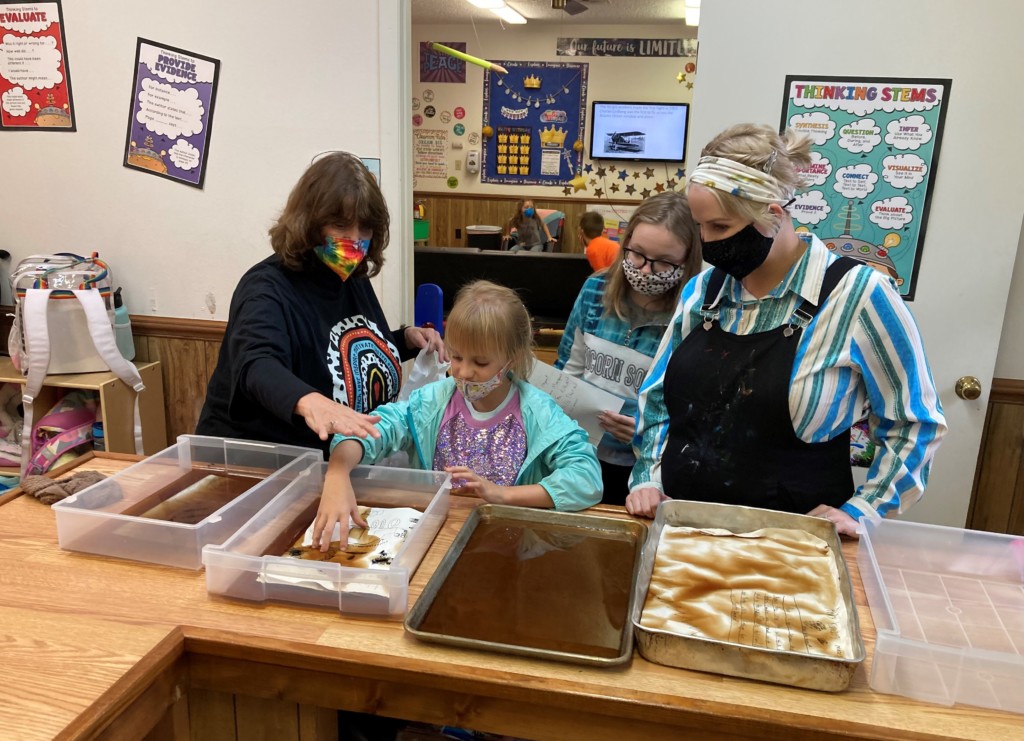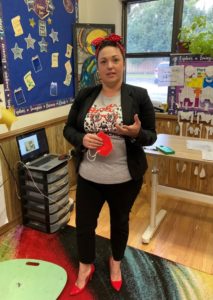
CREATE Conservatory celebrated the 101st day of school with a “101 Dalmatians” theme featuring lesson plans that tied the arts to historical happenings 101 years ago. Students made their own newspapers to show what they learned, soaking the papers in pans of tea to give them the look and feel of old newsprint.
LEESBURG, Fla. – When the time came to begin sketching out plans for her own little school, Nikki Duslak sat in her breakfast nook at 2 a.m. with a notepad, a glass of pinot noir, and a book, “Nonprofit Kit for Dummies.”
Duslak has two master’s degrees in education. She’s steeped in curriculum development and instructional design. She was as motivated as anyone on the planet. Her frustration with conventional schools, building for years, was now boiling over as she saw the toll it was taking on her son.
But sitting there in the middle of the night, Duslak was overcome.
She knew tons about teaching.
She knew zilch about running a school.
“I just sat there and sobbed,” Duslak said.
Duslak is not a crier.
When she was a freshman in high school, her hair fell out due to a rare autoimmune disorder. When other students stared, she told them, “This is what happens when you don’t eat your vegetables.” For a year and a half, she was a stage actor in a comedy that was heavy on improv, and an attorney described her as “the kind of woman who’d charge Hell with a water pistol.”
As a teacher, Duslak exhibited that same fearless streak, ignoring traditional approaches, and, in the process, turbo-charging her students’ learning gains so much she became her district’s Teacher of the Year.
“I don’t know how to do this,” she told herself that first dark night, “but I’m going to do this.”
***

Nikki Duslak spent eight years in public schools but chafed at the restrictive atmosphere. She launched her own school, CREATE Conservatory, in fall 2020. Half of the school’s 14 students attend using school choice scholarships.
Duslak was supposed to use the district-mandated materials to teach writing to eighth graders in her high-poverty school. But she never took them out of the box.
Instead, Duslak used a cross-curricular approach called arts integration. It ties visual and performing arts to math, science, history and other “core” academic subjects, so facts and concepts are more joyfully imprinted, and creativity and confidence get a boost.
The result: On the state’s writing test, her eighth graders came out of nowhere to top the kids at the affluent, A-rated charter school that had long set the bar.
Unfortunately, sweet victories like that weren’t enough to stem the feeling of being stifled. Duslak spent eight years in public schools. She chafed at the atmosphere.
“It’s industrial, it’s cold, the lights are too bright,” Duslak said. “And then, ‘Here’s your lesson plan, you have to do it this way.’ ‘But can I change it here, like this, because it works for me?’ ‘No. This is the way you do it.’ “
At one point, Duslak said, a principal knocked points off her evaluation because she put a poster on the back wall that he wanted on the front wall. Rules like that were “banana pants crazy,” she said – and in her experience, not uncommon.
Four years in, Duslak became an administrator and moved to a charter school. She became an assistant principal at one charter school and then, thanks to her success, was recruited to lead another. But she still couldn’t shape things like she wanted. She ordered bean bags and couches, only to have the management company say no, they’re a liability.
“I ended up having that same claustrophobic feeling,” Duslak said. “I thought, ‘Please trust me to do my job.’ “
Duslak ended up leaving public schools for family reasons. Visions of starting a school danced in her head, but she never made the leap.
Then, in the middle of soccer practice, her 5-year-old broke down and said, “I don’t want to die.”
Avery was in a private school, in a multi-age classroom with students as old as 13. Some of them may have been ready for history lessons about the Holocaust, but Avery was not. After a similar incident earlier, Duslak talked with the staff about age-appropriate content, but clearly, it hadn’t sunk in.
“That’s when I said, ‘I’m doing it. I’m doing it now.’ “
***
CREATE Conservatory opened in fall 2020. It’s half-hidden in a church on the edge of metro Orlando, in what used to be the heart of citrus country.
The K-5 school has two teachers (counting Duslak), two aides, and a handful of volunteers, including Duslak’s mom, a retired public school teacher. This year, CREATE has 14 students, up from seven last year, and it’s already done multiple tours for next year. Half of its students use school choice scholarships, and tuition is $7,000, or roughly 60% of the average per-pupil cost in Florida district schools.
The classroom for the older students feels like a kids’ clubhouse. There’s a hamster cage; a giant stuffed spider; plants on a windowsill that glow from the sunlight streaming through. There are no desks. There are couches and bean bags.
“I try to create environments where children feel comfortable,” Duslak said. “Because when we are comfortable, we are more open to learning and growing.”
CREATE was more than a year in the making.
Duslak had never crafted a business plan before, so she ran the draft by friends with business experience. To spread the word, she did presentations at the library and the arts center, even during breaks in trivia night at local restaurants.
For the facility, she set her sights on a two-story house, and, in anticipation of a zoning change that zoning officials suggested was a gimme, spent $3,000 on surveys and assessments. Two months before school started, the zoning board voted no.
The church turned out to be a good Plan B. But the zoning snafu is a good reminder. Sometimes, for the pioneers, the education frontier ain’t no picnic.
Duslak and her husband (a former public school guidance counselor) sank $50,000 into start-up money for CREATE. At present, she’s not making what she did as a public school teacher, and she’s not saving for retirement.
The paperwork is a bear: payroll, taxes, health insurance, worker’s comp, compliance forms for safety and security – all if it falls on Duslak.
The unexpected challenges don’t stop, either.
Two weeks ago, Duslak was helping a student who appeared to be having an asthma attack when a toilet began overflowing into the hallway. Duslak made sure the student was okay, then, in skirt and heels and looking like a “librarian Rambo,” went to work with a plunger. The water wouldn’t stop.
A plumber told Duslak he was going to have to remove the toilet, which might cause it to break, which would cost the school $400 it didn’t really have. If the problem turned out to be in the septic system – and if it turned out to be the school’s responsibility, like, say, if a student flushed something they shouldn’t have – well, in that case, it could cost thousands.
Thankfully, the toilet didn’t break, and the culprit turned out to be a tree root. Duslak felt “just massive relief.”
Then again, she joked, it was only Tuesday.
***

Duslak, who has two master’s degrees in education, turned to the book, “Nonprofit Kit for Dummies” when she began sketching out plans for her own school.
On the 101st day of school, CREATE Conservatory celebrated with a “101 Dalmatians” theme. The school put a whimsical “Happy 101 Days” sign out front. The K-1 teacher, Ms. Shelby, dressed up like Cruella de Vil. Duslak whipped up lesson plans that tied the arts to historical happenings 101 years ago.
After the students in grades 2-5 watched a slide presentation about the year 1921, they made their own newspapers to show what they learned. They came up with their own newspaper names (“Yesterday’s News!”) and wrote stories about Babe Ruth and Charlie Chaplin and the latest in women’s fashion.
As a final step, they crumpled and uncrumpled the papers and soaked them in pans of tea. Once dry, their creations had the stained look and brittle feel of old newspapers.
Duslak pegs every lesson to Florida state standards in multiple grades and subjects. “Everything we do with the arts is tied into standards,” she said. “It’s not fluffy.”
Does it work?
CREATE uses the Iowa Test of Basic Skills to satisfy state requirements for standardized testing. The first year’s results showed CREATE students on average gained three grade levels in math and reading.
Amber Baraso’s two kids, Hailey and Tyler, were among those making strides.
Now in fifth grade, Hailey struggled in her prior school, especially early in the pandemic, when her teacher never appeared during distance learning. At CREATE, Hailey moved from two grades behind in reading and math to a grade ahead. Tyler, now in third grade, struggled in his prior school because he couldn’t stay seated. At CREATE, students are free to move.
“If we would have stayed in public school, he would not be succeeding. He would have No. 1, been bored out of his skull,” said Baraso, an office manager at a family medical practice.
The arts emphasis is doing wonders, she said. Tyler and Hailey are always working on art projects – there are papier-mâché globes in her closet right now – and gushing about school. “Before it was, ‘How was school today?’ ‘Good,’ “ Baraso monotoned. “Now it’s, ‘We did this! And this! And this!’ ”
CREATE has been perfect for Candice DeMers’s son, too. Gabriel, a first grader, felt lost at his prior school, DeMers said. His self-esteem plummeted. He began to act out.
When the school suggested medication – Gabriel was showing signs of ADHD – DeMers pulled him. Duslak worked with DeMers on a game plan. The results came “almost instantaneously.”
“He’s back to being the loving child he’s always been,” DeMers said. “This is the school I wished I could have gone to when I was a child. It’s just a completely different light.”
***
For a unit on the Earth and sun, Duslak’s students write narratives that explain the interplay of the two to create days and years and seasons. Then they create skits where other students play the Earth and sun and dance out their roles.
After particularly trying days, Duslak has wondered how long she can keep at it. But then, she said, she thinks about her son, safe and thriving, and the other kids who’ve popped out of their shells. Like this one kid, shy but brilliant, who arrived with his confidence shot, but now, during the Earth-and-sun bit, was all smiles and happy feet.
“To see him have a moment of what I like to call flow was just a great gift,” Duslak said. “I see him, getting up and dancing, being the Earth circling the sun, and I’m like, ‘I’m good.’ ”